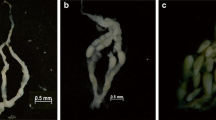Summary
Eight species of carabids (six of them represented by two subpopulations) were sampled. It appeared that the mean number of ripe eggs in the ovaries could be regressed on the specific body weight (ranging from 20 to 285 mg dry wt.): the mean decreased in heavier species, and was higher in the autumn breeders than in the spring breeders. The rate of disappearance of ripe eggs from ovaries, estimated at the end of the reproductive season, was regarded as the egg deposition rate. It turned out to be inversely correlated with the actual female mobility. The calculated fecundities in the separate species and subpopulations with the same type of development could be satisfactorily regressed on the specific body weight. Thus, the developmental type, the specific body weight, and actual female mobility are involved in egg production and deposition.
Similar content being viewed by others
References
Baars MA (1979) Patterns of movement of radioactive carabid beetles. Oecologia (Berlin) 44:125–140
Baars MA, Dijk ThS van (1984) Population dynamics of two carabid beetles at a Dutch heathland II. Egg production and survival in relation to density. J Anim Ecol (in press)
Boer PJ den (1971) On the dispersal power of carabid beetles and its possible significance. Miscell Papers, Landb Hogeschool, Wageningen 8:119–137
Boer PJ den (1977) Dispersal power and survival. Carabids in a cultivated countryside. Miscell Papers, Landb Hogeschool, Wageningen 14:1–190
Boer PJ den (1979a) Some remarks in retrospect. Miscell Papers, Landb Hogeschool, Wageningen 18:213–222
Boer PJ den (1979b) The significance of dispersal power for the survival of species with special reference to the carabid beetles in a cultivated countryside. Fortschr Zool 25:79–94
Brandmayr P, Zetto-Brandmayr T (1979) The evolution of parental care phenomena in Pterostichinae ground beetles, with special reference to the genera Abax and Molops (Coleoptera, Carabidae). Miscell Papers, Landb Hogeschool, Wageningen 18:35–49
Briggs JB (1961) A comparison of pitfall trapping and soil sampling in assessing populations of two species of ground beetles (Col.: Carabidae). Rep E Malling Res Sta 1960:108–112
Brunsting AMH (1981) Distribution patterns, life cycle and phenology of Pterostichus oblongopunctatus F. (Col., Carabidae) and Philonthus decorus Grav. (Col., Staphylinidae). Neth J Zool 31:418–452
Brunsting AMH, Heeseen HJL (1984) Density regulation in the carabid beetle Pterostichus oblongopunctatus F. (Col., Carabidae). J Anim Ecol (in press)
Burgess AF (1911) Catosoma sycophanta: its life history, behavior, and successful colonization in New England. Bull. Bur. entomol. US Dept Agr 101:1–94
Dijk ThS van (1972) The significance of the diversity in age composition of Calathus melanocephalus L. (Col., Carbidae) in space and time at Schiermonnikoog. Oecologia (Berlin) 10:111–136
Dijk Th S van (1973) The age-composition of populations of Calathus melanocephalus L. analysed by studying marked individuals kept within fenced sites. Oecologia (Berlin) 12:213–240
Dijk ThS van (1979a) On the relationship between reproduction, age and survival in two carabid beetles: Calathus melanocephalus L. and Pterostichus coerulescens L. (Coleoptera, Carabidae). Oecologia (Berlin) 40:63–80
Dijk ThS van (1979b) Reproduction of old and young females in two carabid beetles and the relationship between the number of eggs in the ovaries and the number of eggs laid. Miscell Papers, Landb Hogeschool, Wageningen 18:167–183
Ernsting G, Jager JC (1978) IV. Effects of food deprivation, soil moisture and environmental conditioning by prey on locomotory activity of the predator Notiophilus biguttatus (Coleoptera: Carabidae). In: Ernsting G (ed) Predation on springtails. Wageningen: Ernsting, pp 61–71
Grüm L (1959) Seasonal changes of activity of the Carabidae. Ekol pol A 7:255–267
Grüm L (1966) Diurnal activity rhythm of starved Carabidae. Bull Acad pol Sci, Cl II, 14:405–411
Grüm L (1967) Remarks on fluctuations in density of Carabidae populations. Ekol pol A 15:335–345
Grüm L (1971) Spatial differentiation of the Carabus L. (Col., Carabidae) mobility. Ekol pol 19:1–34
Grüm L (1973) Egg production of some Carabidae species. Bull Acad pol Sci, Cl II, 21:261–268
Grüm L (1975) Mortality patterns in carabid populations. Ekol pol 23:649–665
Grüm L (1976) Biomass production of carabid-beetles in a few forest habitats. Ekol pol 24:37–56
Grüm L (1978) Mechanisms governing rate and direction of energy flow through carabid populations. Pol ecol Stud 4:129–175
Grüm L (1980) Methods of approximate estimation of energy flow through carabid populations. Ekol pol 28:129–149
Grüm L (1982) Some aspects of fluctuations in the population density of carabid beetles. In: Mossakowski D, Roth G (eds) Environmental adaptation and evolution. Fischer, Stuttgart, pp 253–272
Heessen HJL (1980) Egg production of Pterostichus oblongopunctatus (Fabricius) (Col., Carabidae) and Philonthus decorus (Gravenhorst) (Col., Staphylinidae). Neth J Zool 30:35–53
Heessen HJL (1984) Egg mortality in Pterostichus oblongopunctatus (Fabricius) (Col., Carabidae). Oecologia (Berlin) (in press)
Larsson SG (1939) Entwicklungstypen und Entwicklungszeiten der dänischen Carabiden. Ent Meded 20:277–560
Luff ML (1973) The annual activity pattern and life cycle of Pterostichus madidus (F.) (Col., Carabidae). Ent Scand 4:259–273
Marsh TG (1969) Ecological and behavioral studies on the cave beetle Darlingtonea kentuckensis Valentine (Coleoptera: Carabidae). Univ of Kentucky, unpublished Ph D thesis, p 171
Mols PJM (1979) Motivation and walking behaviour of the carabid beetle Pterostichus coerulescens L. at different densities and distributions of the prey. Miscell Papers, Landb Hogeschool, Wageningen 18:185–198
Murdoch WW (1966) Population stability and life history phenomena. Amer Natur 100:5–11
Paarmann W (1966) Vergleichende Untersuchungen über die Bindung zweier Carabidenarten (P. angustatus Dft. und P. oblongopunctatus F.) an ihre verschiedenen Lebensräume. Z wiss Zool 174:83–176
Richoux P (1972) Ecologie et ethologie de la faune des fissures intertidales de la région malouine. Bull Lab Marit Dinnard 1:145–206
Thiele HU (1977) Carabid beetles in their environments. Springer, Berlin Heidelberg New York
Wasner U (1979) Zur Ökologie und Biologie sympatrischer Agonum (Europhilus)-Arten (Carabidae, Coleoptera) I. Individualentwicklung und Gonadenreifung, Generationsaufbau, Eiproduktion und Fruchtbarkeit. Zool Jb Syst 106:105–123
Author information
Authors and Affiliations
Rights and permissions
About this article
Cite this article
Grüm, L. Carabid fecundity as affected by extrinsic and intrinsic factors. Oecologia 65, 114–121 (1984). https://doi.org/10.1007/BF00384473
Received:
Issue Date:
DOI: https://doi.org/10.1007/BF00384473



